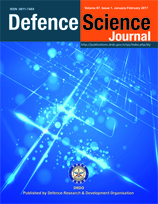Application of a Winch-type Towed Acoustic Sensor to a Wave-powered Unmanned Surface Vehicle
DOI:
https://doi.org/10.14429/dsj.67.10577Keywords:
Winch-type acoustic sensor, Wave-powered, Unmanned surface vehicleAbstract
Although many countries have focused on anti-submarine warfare for several decades, underwater submarines can hardly be detected by current assets such as patrol aircraft, surface ships and fixed underwater surveillance systems. Due to the difficult conditions of the oceanic environment and the relative quietness of submarines, existing acoustic surveillance platforms are not able to fully cover their mission areas. To fill in the gaps, a winch-type towed acoustic sensor system was developed and integrated into a wave-powered unmanned surface vehicle by the Korea Institute of Ocean Science and Technology. In June 2015, sea trial tests were conducted to verify maneuvering, acoustic signal detection, and communication capabilities. During the maneuvering test, the wave-powered glider successfully moved along programmed waypoints. Despite towing the acoustic sensor system, only 20% of initial electricity was consumed in 20 days. The acoustic sensor was lowered to depths of 100–150 m by the winch system, and received signals from an acoustic simulator lowered to depths of 50–100 m by RV Jangmok. Simulated submarine noises that were refracted downward could be clearly received and classified by the hydrophone system, from distances of 2–8 km, while it was being towed silently and deeply. In addition, an optical camera provided high-resolution images of surface vessels, allowing integration with acoustic detection of underwater objects. In conclusion, this new platform using a deeply towed hydrophone system is worthy of consideration as an underwater surveillance asset. Future work is required to strengthen inter-asset communication and obstacle avoidance, and to overcome strong currents to make this technology a reliable part of the underwater surveillance network.Downloads
Published
2016-12-23
How to Cite
Moh, T., Jang, N., Jang, S., & Cho, J. H. (2016). Application of a Winch-type Towed Acoustic Sensor to a Wave-powered Unmanned Surface Vehicle. Defence Science Journal, 67(1), 125–128. https://doi.org/10.14429/dsj.67.10577
Issue
Section
Naval Systems
License
 Where otherwise noted, the Articles on this site are licensed under Creative Commons License: CC Attribution-Noncommercial-No Derivative Works 2.5 India
Where otherwise noted, the Articles on this site are licensed under Creative Commons License: CC Attribution-Noncommercial-No Derivative Works 2.5 India


